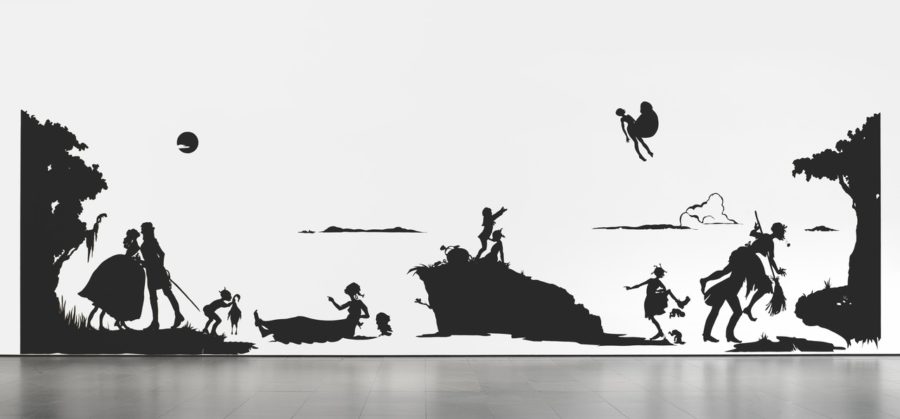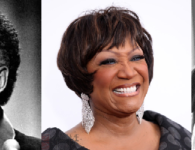Early Life:
Kara Walker was born on November 26, 1969, in Stockton, California. Walker’s passion for artistic expression was inherited from her parents. Larry was a former art teacher. Her mother, Gwendolyn, was a seamstress. At 13, her family relocated to Georgia. Walker witnessed Black racial struggles. This experience prompted her to include them in her art.
Art Career:
Walker pursued art in her college studies. She graduated with a B.A. from the Atlanta College of Art in 1991. Walker went further, earning her Master’s from the Rhode Island School of Design. It is here where she crafted her signature medium, silhouettes.
That same year, Walker’s piece Gone, an Historical Romance of a Civil War as It Occurred Between the Dusky Thighs of One Negress and Her Heart, appeared at the Drawing Center located in New York. Blacks are depicted in the artwork in the Antebellum South. Walker included images of a black female giving birth abundantly this represents the breeding that the enslaved had to endure. Also depicted is a female providing sexual pleasures to a white male, this represents the power dynamic and also sexual abuse that took place during Slavery.
 Walker has been recognized in magazines and newspapers. In June 2007, Walker was interviewed by The New Yorker’s Hilton Als. During the interview, Walker resonated on a talk she gave in 2000 at the Des Moines Art Center. There was a question asked during the “Question and Answer” segment. A white man asked Walker about her continuation of being an active artist while showcasing the themes for which she has become known. Walker’s responded with, “Oh, probably as long as I’m black and a woman.” This response is only is a testament to the intersectionality of race and gender that black women battle every day.
Walker has been recognized in magazines and newspapers. In June 2007, Walker was interviewed by The New Yorker’s Hilton Als. During the interview, Walker resonated on a talk she gave in 2000 at the Des Moines Art Center. There was a question asked during the “Question and Answer” segment. A white man asked Walker about her continuation of being an active artist while showcasing the themes for which she has become known. Walker’s responded with, “Oh, probably as long as I’m black and a woman.” This response is only is a testament to the intersectionality of race and gender that black women battle every day.
Accolades:
Walker should be commended for her CV. In 1997, Walker earned the MacArthur genius award at 27. For this reason, Walker was one of the youngest recipients ever. Since then, she has had her collections showcased around the world, such as The Tate Gallery in London and Deutsche Bank in Frankfurt, Germany.
Ivy League school, Columbia University recognized Walker’s success and knowledge by offering her a professorship. She has held this position for over a decade.
For more information visit the following sites:





















2 Comments
dailyxetaihino Thanks for sharing your thoughts.
I wanted to communicate my admiration for the articles, historical content, photos and artwork you provide in your newsletter on a regular basis to assist African Americans in putting the pieces of our lives together. A puzzle of contributions from many individuals known and unknown that that have gone unnoticed for many years. I recently reviewed a website entitled “Vanishing North Georgia.com” with a compilation of photographs of historic sites, bridges, country stores, rivers and large, White Antebellum homes (Plantation Plain I-Houses and sheds) with their stunning and iconic Greek and Ionian pillars and porticos and saddlebag homes (in a state of disrepair). I also noted that the compilation contained many primarily White Antebellum mansions many in a state of pristine condition. Growing up these areas to me were rich, beautiful and apart from the Black section of town located across the railroad track. It did not represent the world my community knew other than in passing in order to get to our side of the street beyond the railroad track. If I don’t write my own history, who will write it for me? After the question was asked, did individuals of African ancestry own slaves, I located a really interesting painting that I wanted to share entitled… Agostino Brunias (Italian, ca. 1730-1796). Free Women of Color with Their Children and Servants in a Landscape, ca. 1770-1796. Oil on canvas, 20 x 26 1/8 in. (50.8 x 66.4 cm). Brooklyn Museum, an oil painting of a Caribbean sugar plantation, and two luxuriously dressed mixed-race sisters enjoying a walk with their mother, children, and eight African servants. Interesting, yet sad because the idea of slavery and remnants of its evil past still haunts us very much today… https://www.brooklynmuseum.org/opencollection/objects/197252